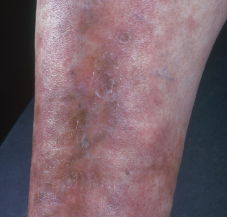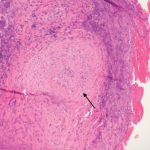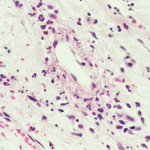WASHINGTON, D.C.—Rheumatologists do not have up-to-date diagnostic and classification criteria for vasculitis, a group of diseases that involves inflammation of the blood vessels, said experts speaking at the 2016 ACR/ARHP Annual Meeting session, Classification Criteria for ANCA-Associated Vasculitis. The most recent classification criteria were published by the ACR in 1990, and since then, new disease definitions and diagnostic tests have changed the way the vasculitides are diagnosed and treated.1
“Microscopic polyangiitis [MPA] was not even a recognized entity in the 1980s, when the last classification criteria were developed, so it was missing from the 1990 ACR criteria,” said Ravi Suppiah, MBChB, MD, FRACP, one of the lead investigators of a new study to develop updated vasculitis criteria and a rheumatologist at the Auckland District Health Board in New Zealand. “Most patients who were included in the original ACR classification criteria who had, or [who] we would think of now as having, MPA, were classified as having polyarteritis nodosa.”
To address this need, a multiyear project was undertaken to develop new classification and diagnostic criteria that incorporate current disease definitions, medical technologies and therapies. The ongoing study, called the Diagnostic and Classification Criteria in Vasculitis Study (DCVAS), includes data on more than 6,300 vasculitis patients from more than 100 sites worldwide, and recruitment will continue through June 2017. Because of their interest in supporting classification criteria development, the ACR and the European League Against Rheumatism (EULAR) have contributed funding to the project.
During the session, lead investigators of the study presented a draft of classification criteria for GPA, the first set the study has produced. Classification criteria for MPA, eosinophilic granulomatosis with polyangiitis (EGPA) and ANCA-associated vasculitis (AAV) will be released shortly.
“Why do we need new criteria? The 1990 ACR criteria no longer fit the purpose,” said Dr. Suppiah. “They don’t correlate and are not consistent with our current definitions of these disease conditions,” he added, referring to the Chapel Hill Consensus conference definitions for vasculitis created in 2012.2 “Widely used tests for anti-neutrophil cytoplasmic antibodies (ANCA) and imaging techniques like computed tomography were not routinely available in clinical practice in the 1980s. Basically, it’s time for an update.”
‘Why do we need new criteria? The 1990 ACR criteria no longer fit the purpose. They don’t correlate & are not consistent with our current definitions of these disease conditions. It’s time for an update.’ —Dr. Suppiah
Classification criteria are used for research, not diagnosis, said co-investigator Peter Grayson, MD, PhD, head of the Vasculitis Translational Research Program at the National Institute of Arthritis and Musculoskeletal and Skin Diseases in Bethesda, Md.
“The intent is to identify similar groups of patients so that we can standardize recruitment into clinical trials and related studies. Often, the line is blurred between diagnostic and classification criteria,” said Dr. Grayson. “Unlike many classification criteria in the rheumatic diseases, we didn’t include mimics of vasculitis in our comparator groups. This is important. The intent of these criteria is to differentiate between different types of vasculitis, and the assumption of these criteria is that a diagnosis of vasculitis has already been made.”
These new, draft GPA classification criteria were developed with two methodology advancements, said Dr. Grayson. Instead of using a numerical scoring method in which each criterion carried the same weight, these criteria apply a different weight or score to each criterion and include a threshold score to achieve classification of the condition. In addition, the investigators created a gold standard that must be met in order to say a patient has the condition.

Vasculitis, the inflammatory destruction of blood vessels, is often an accompanying symptom of a rheumatic disease.
Biophoto Associates / Science Source
“Historically, submitted physician diagnosis or opinion was the gold standard, but the problem with that is that it can be biased,” said Dr. Grayson. “Previous classification criteria could influence opinions, so we utilized consensus expert panel reviews to validate the submitting physician diagnoses and establish the diagnostic gold standard.”
The study to develop the draft classification criteria included three phases, said Cristina Ponte, MD, a rheumatologist at the Hospital de Santa Maria in Lisbon, Portugal. The first phase was case selection, including a clinical expert panel review of case vignettes for quality control. Panelists reviewed each case to determine if the patient had vasculitis, and if so, what size vessels were affected, if it was ANCA-associated or not and its subtype. Detailed clinical, laboratory and radiological information on each patient case was included in the DCVAS online database. Consensus of at least two experts was needed to include the case.
In the second phase, the investigators selected 91 vasculitis-
related items from the previously agreed cases, on the basis of their prevalence or importance, for inclusion in a Lasso logistic regression model, said Dr. Ponte. The third phase was the creation of the final draft criteria, which used combined data-driven and clinical expert review, and then the models were tested for face validity and discrimination.
At the end of the process, nine items were included in the draft 2017 Provisional Classification Criteria for Granulomatosis with Polyangiitis (GPA) to use when a diagnosis of small- or medium-vessel vasculitis has been made and to classify the patient as having GPA, said Joanna Robson, BSc, PhD, MRCP, consultant senior lecturer in rheumatology at the University of West England in Bristol. Each item received either a positive or negative score, and when all items scores are added, the patient must reach a score of 5 or more to be classified as having GPA, she said.
Clinical Items & Their Scores
- Bloody nasal discharge, ulcers, crusting or sino-nasal congestion: 3
- Nasal polyps: –4
- Hearing loss or reduction: 1
- Cartilagenous involvement: 2
- Red or painful eyes: 1
Test Result Items & Their Scores
- c-ANCA- or PR3-antibody positive: 5
- Eosinophil count ≥1 (x109/L): –3
- Nodules, mass or cavitation on chest imaging: 2
- Granuloma on biopsy: 3
Renal impairment was highly prevalent in both cases and comparators, and did not emerge as discriminatory for GPA, said Dr. Robson. Kidney involvement will be a crucial item when diagnostic criteria are developed. DCVAS will seek endorsements from the ACR and EULAR for these classification criteria.
What are the clinical implications for the updated classification criteria? They are a useful tool for rheumatology researchers because they reflect modern disease definitions and tests, said Richard Watts, honorary senior lecturer at Norwich Medical School at the University of East Anglia in the U.K. “These provisional criteria are clinically based, reflect current investigative practices and include ANCA, but they are not critically dependent on ANCA, nor on biopsy,” he said. “They provide a risk-based score rather than the old X-of-Y methodology, and have good specificity and sensitivity. They should be used for research purposes, but they will also improve the evidence base for decisions on therapy.”
Susan Bernstein is a freelance journalist based in Atlanta.
Miss Any of These Important Sessions?
If you missed any of these important sessions, find them on SessionSelect.
References
- Leavitt RY, Fauci AS, Bloch DA, et al. The American College of Rheumatology 1990 criteria for the classification of Wegener’s granulomatosis. Arthritis Rheum. 1990 Aug;33(8):1101–1107.
- Jennette JC, Falk RJ, Bacon PA, et al. 2012 revised International Chapel Hill Consensus Conference nomenclature of vasculitides. Arthritis Rheum. Jan 2013;65(1):1–11.



